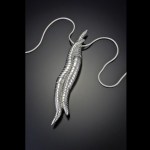biology
Just in time for Valentine's Day: the "Copulating Earthworm Necklace," from heronadornment on etsy.
Also love her anatomical heart locket.
tags: animals, fish, ribbonfish, oarfish, Regalecus glesne, sea serpent,marine biology, Mark Benfield, streaming video
A huge oarfish, also known as the ribbonfish, Regalecus glesne, was caught on camera in the Gulf of Mexico, giving scientists a rare glimpse of the bizarre fish in its native deep sea habitat. This is probably the largest bony fish in the seas, and it has the distinctive habit of swimming vertically (head up). Researcher Mark Benfield describes the fish, a likely inspiration for the sea serpent myth.
On Tuesday, Feb. 23, National Geographic Explorer will be devoting an episode to "Vampire Forensics." You can preview a brief clip below the fold, but I'll warn you now: it's not CSI. It's more scientific ("unfortunately this evidence is inconclusive" LOL) and less sexy (inexplicably, Emily Proctor is nowhere to be seen). Overall, the feeling I got from the clip was sort of "Wow, we're National Geographic Explorer, that's pretty great, but we really wish we were sexy, like CSI. Does this sinister music help?"
In conjunction with the Explorer episode, National Geographic is releasing a book…
It literally took me a good 20 seconds to figure out what was. . . off. . . about the first photo in this great post by Emily at SheChive. Sigh. ;)
Thanks to Jake for the heads-up!
Figure 1. Relationship between normalized metabolic rate and body mass for unitary organisms and whole colonies (from Hou et al 2010)
The notion that insect colonies and their constituent individuals are analogous to multicellular organisms and their constituent cells has been a controversial idea for decades. Is it useful, for example, to think of an ant colony as a single individual? Do superorganisms really exist as coherent entities? Or do insect colonies function more as aggregations of individuals?
Last week, PNAS published the first application of empirical methods to test the…
tags: environment, education, conservation,animal welfare, dancing bears, India, sloth bear, Kartick Satyanarayan, TEDTalks, streaming video
Traditionally, the Kalandar community of India has survived by capturing sloth bear cubs and training them to "dance" through extreme cruelty. Kartick Satyanarayan has been able to put an end to this centuries-old practice, and in so doing discovered a lesson of wider significance: make the practitioners part of the solution.
TEDTalks is a daily video podcast of the best talks and performances from the TED Conference, where the world's leading thinkers…
Well, not quite. I got an intriguing abstract in my inbox earlier today, to this new paper from BMC Neuroscience:
Here using a new conditioned suppression paradigm, we investigated whether the ability of a foot-shockpaired conditioned stimulus to suppress chocolate-seeking behavior was antagonized by previous exposure to a chronic stressful experience, thus modeling aberrant chocolate seeking in sated mice. Our findings demonstrate that while Control (non-food deprived) animals showed a profound conditioned suppression of chocolate seeking during presentation of conditioned stimulus,…
tags: evolutionary biology, molecular biology, Thoroughbred race horses, horses, aerobic capacity, muscle development, myostatin, MSTN, myostatin-suppressing C variant, myostatin-suppressing T variant, Horse Genome Project, Equinome, researchblogging.org, peer-reviewed research, peer-reviewed paper
Emerging from the mist is Rachel Alexandra, a champion American Thoroughbred who excels at winning both long and short distance races.
Image: Rob Carr, 2009, Associated Press [larger view]
If you've worked at or been around a racetrack very much, as I have, you'll quickly realize that everyone…
tags: evolutionary biology, paleontology, taphonomy, plumage color, feathers, color, melanin, eumelanin, phaeomelanin, dinosaurs, theropod, paravian, avialae, fossils, Anchiornis huxleyi, ornithology, birds, researchblogging.org,peer-reviewed research, peer-reviewed paper
New research reveals that recently-described 155-million-year-old Anchiornis huxleyi,
a woodpecker-like dinosaur the size of a modern-day domesticated chicken,
had black-and-white spangled wings and a rusty red crown.
Image: Michael DiGiorgio, Yale University [larger view]
Fig. 4. Reconstruction of the plumage color of…
On February 2, The Immortal Life of Henrietta Lacks by ScienceBlogger Rebecca Skloot was officially published. If you haven't heard, everyone who has read this book has wonderful things to say. Dr. Isis on On Becoming a Domestic and Laboratory Goddess declares it "the single best piece of non-fiction I have ever read. It is one of the most important stories of the last 100 years and should be required reading for every scientist and physician-in-training." Henrietta Lacks was a poor Southern tobacco farmer whose cervical cancer cells gave rise to the first immortal human cell line. Long…
Seaweed Picture No. 31
Alyson Denny
Photographer Alyson Denny's closeups of seaweed and jellyfish couldn't be less like your usual natural science documentation. Often, very little of her subject is in focus; she's more concerned with how the forms and colors blur and overlap as the field recedes. From a distance, her photographs are dazzling abstractions; the jellyfish photos are reminiscent of jewel-encrusted sets for high-end, artsy diamond ads. But when you realize what the subjects are, you also realize that her photos are just what you'd see if, like a child, you were lying on the…
Here are some of the thoughts and questions that stayed with me from this session. (Here are my tweets from the session and the session's wiki page.)
Among other things, this panel took up the article panelist Lindsey Hoshaw wrote about the garbage patch for the New York Times and some of the reaction to it (including from panelist Miriam Goldstein).
Lindsey's article was interesting because of the process. To get a spot on the ship going out to the North Pacific gyre, where the garbage patch is, she had to come up with funding. (We learned during the session that ship time on some of…
As people who have been following the issue are well aware, there is a crisis of scientific literacy in the United States. Unscientific America may have had a poor explanation for why the problem exists, but it effectively announced the severity of the problem to a wide audience. To combat this problem it will take a a great diversity of tactics including education, popular culture, involved parenting, economics and political will. Everyone who cares about this issue should use the skills they have to both draw attention to the crisis of scientific literacy and seek positive solutions.
One…
...are at it again:
The twilight zone:
ambient light levels trigger activity in primitive ants
What's unfortunate about this title is that the judgement "primitive" has nothing to do with the research. It is unnecessary. The study is about how one species of ant uses ambient light levels to trigger foraging. It's a nicely done bit of work. But whether or not these ants are "primitive" has zilch to do with the science.
Back in the day, western anthropologists would study Primitive Culture. Such terms are no longer used in that field, and for good reason. It's not just that…
Occasioned by a comment on my recent entry on the movie Avatar and the Gaia hypothesis, here's a re-run of a blog entry from March 2006.
As comments to a recent entry, I've had an interesting discussion about environmentalism with a friend. We both agree that biodiversity and ecological systems should be preserved. But we disagree as to the reason for this.
If I understand my friend correctly, her opinion is that we should preserve biodiversity because it is precious (or even holy?) without reference to the needs and wishes of humans. Let's say she feels biodiversity is an abstract good.
My…
Why time goes slower when we get older
Rhonald Blommestijn
for Douwe Draaisma interview, Audi Magazine
Dutch graphic designer Rhonald Blommestijn's illustrations play with medical and technical themes in unexpected ways. Check out his blog, and his series of concept illustrations for the Netherlands Organisation for Scientific Research (NWO).
The Effect of Playstation on the Human Body
Rhonald Blommestijn
For Playstation Belgium
Rhonald Blommestijn
For the Netherlands Organisation for Scientific Research (NWO)
It's time for the annual Global Population Speak Out. We all know that in order not to crash the planet we need to consume less energy and raw materials and we need to emit less pollutants. But it doesn't seem to be generally known that nothing an affluent Westerner does can have anywhere near as beneficial an effect on the future environment as not having kids. Riding a bike to work, recycling milk cartons, turning off the outdoor lamp before you go to bed -- all of those green efforts of yours will be swamped and obviated if you have that extra kid.
Think about it. If there were only a few…
Great flocks of fieldfares (Turdus pilaris, björktrast) are hanging around Boat Hill, feeding off the frozen parkland rowan berries instead of migrating. They're so ruffled up against the cold that they're hardly recognisable as the streamlined summer birds we're used to. Their cousins the blackbirds sit alone like big black apples here and there in the leafless underbrush, waiting for the singing season.
[More blog entries about birds, photography; fåglar, foto.]
Via my friend Sylvia, here's an old (2008) but interesting post arguing that over time, the quality of medical illustrations have declined. From Artemy Lebedev.
tags: evolutionary biology, fossils, feathers, plumage color, color, dinosaurs, theropods, Sinosauropteryx, Sinornithosaurus, birds, Confuciusornis, melanosomes, phaeomelanosomes, eumelanosomes, keratinocytes, SEM, scanning electron microscopy, 10.1038/nature08740, researchblogging.org, peer-reviewed research, peer-reviewed paper
Reconstruction of two Sinosauropteryx, sporting their orange and white striped tails.
Artwork by Chuang Zhao and Lida Xing [larger view]
DOI: 10.1038/nature08740
While looking at museum dioramas that feature dinosaurs, I often overhear people asking "How do they…





